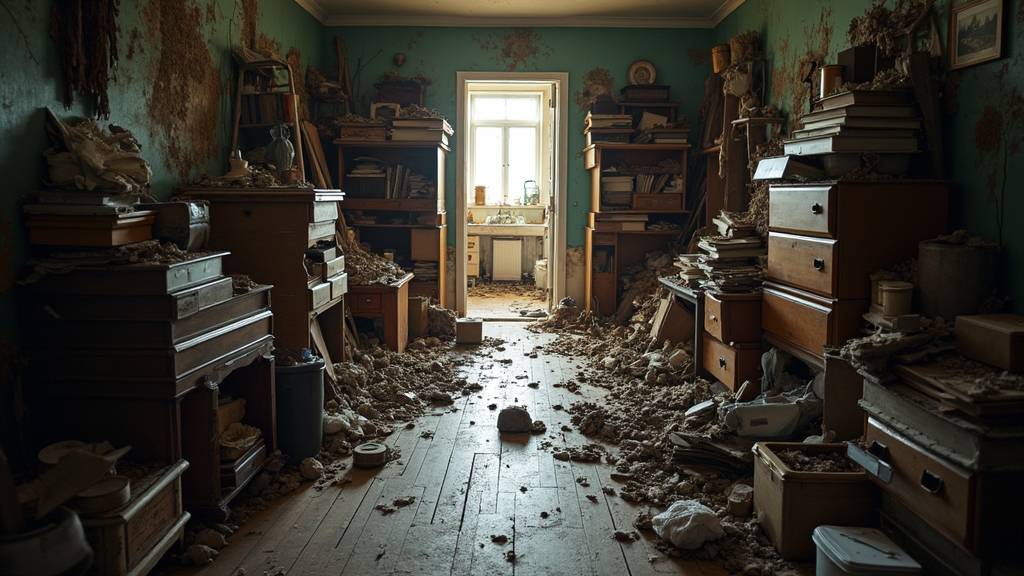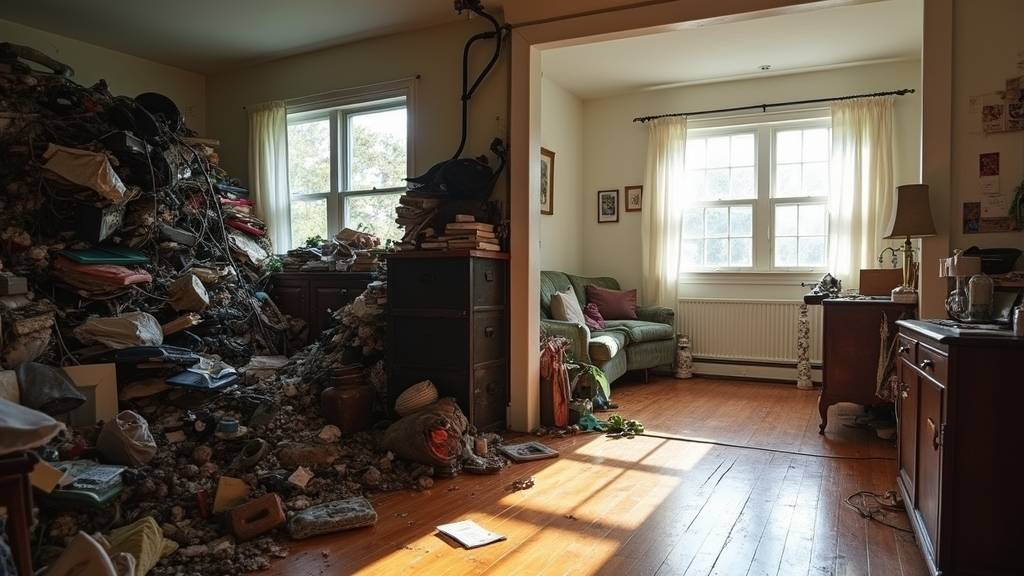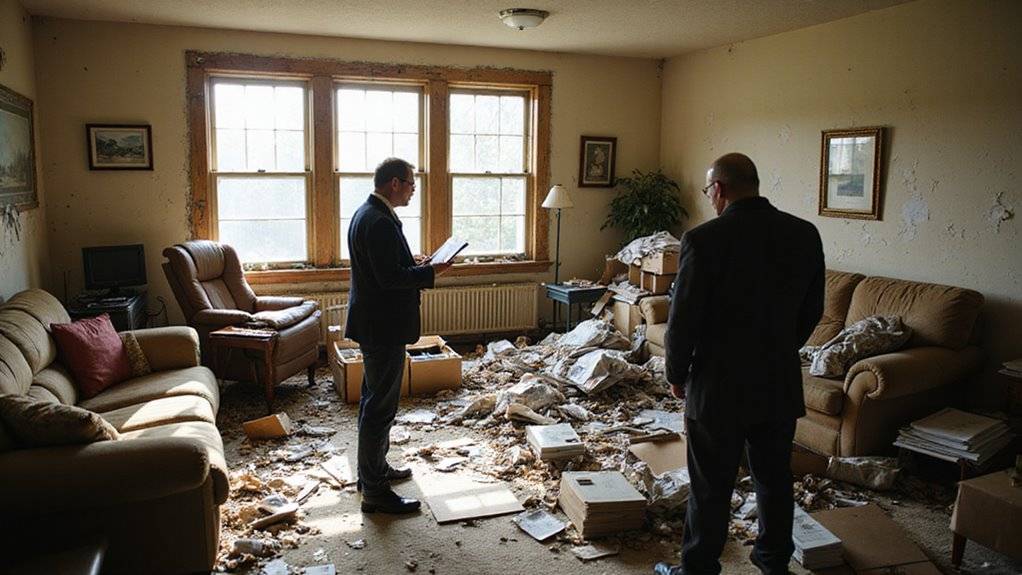Selling a hoarder house can feel overwhelming. You must choose whether to sell as-is or invest in repairs. Each choice affects your timeline, stress, and profit.
The process is rarely simple. You may face difficult emotions, complex legal rules, and buyers who hesitate. Repairs can mean extra costs, while selling as-is may lower your price.
The best way to sell a hoarder house depends on your goals, budget, and risk tolerance. You should weigh the pros and cons of each path.
Careful planning can save you money and stress. This blog will guide you through your options so you can confidently decide how to sell your hoarder house.
Key Takeaways
- Selling as-is avoids repair costs and speeds up the process, but usually results in lower offers and attracts fewer buyers.
- Repairing the house increases market value by up to 20% and appeals to a broader pool of traditional buyers.
- Full disclosure of known issues is legally required, regardless of selling as-is or after repairs, to avoid future liability.
- Cleanup and minor upgrades, even when selling as-is, can boost appeal and slightly increase offers from investors.
- Weigh emotional and financial costs; repairs may not recoup full investment, but can reduce negotiation and inspection issues.
Understanding What Qualifies as a Hoarder House

A house is called a hoarder house when clutter or items make it unsafe or hard to use. Blocked exits and dirty surfaces are common signs. Rooms are often filled so much that normal living is not possible. Hoarding disorder affects about 2-6% of people, according to the International OCD Foundation.
This condition can cause serious health and safety problems. If the house is not cleared, home staging is almost impossible. A hoarder house can lower nearby property values and scare away buyers. If you want to sell, you must understand these challenges.
Planning ahead helps you set realistic goals and find good solutions. Understanding the conditions of hoarding can assist sellers in making informed decisions and seeking appropriate support. Recognizing the complexities of hoarding behaviors can also guide you toward effective cleanup and sale strategies.
Assessing the Condition of the Property
Assessing the condition of the property means checking what shape the house is in. Walk through each room and write down any problems you see. Look for things like broken walls, safety issues, and piles of clutter.
You should hire a licensed inspector to find hidden problems. The inspector can check for mold, pests, or damaged pipes you might not notice. If there are big issues, fixing them could change the value of your house.
The disclosure requirements mandate that sellers reveal all known defects, so understanding your property’s condition helps you comply with legal obligations and avoid future liabilities. Additionally, reviewing contract restrictions can prevent legal complications if you decide to sell as-is or make repairs.
Compare your house to similar homes recently sold in your area. Check both homes sold “as-is” and those that were fixed up. This information helps you figure out your possible selling price.
If you know what repairs are needed, you can decide which ones matter most. Use your notes and market research to set realistic goals. With good information, you can make a smart plan to sell your house.
Weighing the Emotional and Financial Costs

You’ll need to balance the stress of tackling a hoarder cleanup against the possible increase in sale price. Studies show that homes sold as-is typically fetch 20-30% less than those in market-ready condition. Consider whether the emotional and financial strain of repairs is worth the possible return.
Additionally, selling to a local cash home buyer can simplify the process, allowing you to sell quickly and without the need for repairs. Choosing a stress-free selling approach can save time and reduce the emotional burden during a challenging situation.
Stress of Cleanup Process
Cleaning out a hoarder house is stressful and costly. The process involves more than just moving items; it can affect your emotions and finances. Clutter can hide mold, pests, or even damage to the house.
These problems can make the work harder and risk your health. Sorting through belongings may cause stress, anxiety, or sadness. If the items belong to a loved one, the feelings can be stronger.
Professional help can cost between $1,000 and $10,000 or more. Doing it yourself still means paying for dumpsters, supplies, and your time. You should think carefully before starting. If you are not ready for the emotional or financial strain, consider getting support.
Impact on Sale Price
Cleaning or repairing a hoarder house can raise the sale price by 10% to 20%. This depends on your local housing market. A clean and fixed home usually sells for more.
Buyers often prefer homes that are move-in ready. More offers and faster sales are likely with a tidy, repaired property. If you leave the house as-is, expect a price drop of 30% or more.
Some buyers may subtract the cost and work of repairs from their offer. Minor repairs and deep cleaning can help you earn more money. If repairs seem too hard or expensive, selling as-is might be better for you.
Benefits of Selling a Hoarder House As-Is
Selling a hoarder house as-is can save you time and money. You do not need to make repairs or clean deeply. This option lets you skip expensive upgrades.
If you sell as-is, you can often sell your house faster. Many buyers, like investors, look for homes in any condition. They usually do not expect you to stage or declutter the house.
You avoid hiring contractors or managing repairs if you sell as-is. This reduces your stress and out-of-pocket costs. The process becomes much simpler and more practical.
Drawbacks of Selling As-Is

Selling a hoarder house as-is often results in lower offers. Buyers will lower their price because of needed cleaning and repairs. The home’s condition reduces its market value. Additionally, the clutter and damage can deter many potential buyers, especially those looking for move-in ready homes.
You skip home staging, which usually helps attract more buyers. Clutter and visible damage make the house less appealing. This limits your buyers mostly to investors looking for deals. Investors usually offer much less than the market price. Sometimes, the offers can be 30-50% below what you might expect. Some lenders may not approve loans for homes in poor shape. If your home is very distressed, you may have fewer buyers.
Selling as-is is faster, but you often lose a lot of potential profit. Consider these drawbacks before deciding to sell without repairs. Selling as-is can also reduce your chances of a quick sale, especially if the property requires extensive repairs or cleanup. Properly assessing the property’s mold and structural issues can help you decide whether repairs are worth the investment for a higher sale price.
Advantages of Making Repairs Before Selling
If you invest in repairs before listing, you’ll likely boost your home’s sale price—studies show renovated properties can sell for up to 20% more. You’ll also appeal to a broader pool of buyers who prefer move-in ready homes. This strategy can shorten your time on the market and maximize your return.
Additionally, making repairs can help you sell your house without an agent more efficiently by attracting serious buyers quickly. Properly documenting your improvements can also help ensure you qualify for any applicable capital gains tax exclusions if you meet the residency requirements.
Higher Sale Price Potential
Making repairs before selling can help you get a higher sale price. Buyers will often pay more for homes that are ready to move into. Updated homes attract more interest and better offers.
Repairs and updates show buyers the home is cared for. This can lead to buyers feeling more confident and willing to pay extra. If you invest in repairs, you may also avoid price cuts during negotiations.
A well-kept home makes a good first impression. Modern features will increase the value buyers see in your property. If inspection reports look better, buyers are less likely to back out.
Attracting More Buyers
Making repairs before selling a hoarder house helps attract more buyers. Most buyers want homes they can move into right away. If you fix problems and update interiors, you will appeal to more people.
Simple updates like new paint or flooring can make a big difference. Home staging also makes rooms look larger and more welcoming. If the house looks inviting, you will likely get more showings and offers.
If you sell as-is, you may only attract investors looking for a bargain. By improving the house, you increase your chances of a faster and better sale.
Potential Downsides of Repairing a Hoarder House
Repairing a hoarder house can be much harder and more expensive than you might think. If you plan to fix it up, you may face challenges that do not happen with regular homes. These problems can make the process longer and costlier.
Hoarder homes often hide serious repair needs, such as structural or safety problems. Clearing out the house usually takes much more time than you expect. If emotional ties exist, sorting through items can become very stressful.
Moving costs can also increase because of the amount of stuff inside. If you need to store or remove many things, costs will be higher. These issues can make repairing a hoarder house overwhelming for many homeowners.
Additionally, fair cash offers from local investors can help you avoid the stress and expense of repairs by allowing you to sell the property as-is. Furthermore, the presence of hidden damage can complicate the repair process and inflate costs unexpectedly.
Cost vs. Value: Analyzing Repair Investments
Repairing a hoarder house can increase its market value, but not always enough to cover your costs. You should compare every dollar spent with the expected return. If the repairs are too expensive, you might not make a profit.
You should get several repair estimates so you know the real costs. Comparing these costs to the value of similar homes in your area is important. National data shows that most repairs only recover about 60% to 70% of their cost.
If you have an emotional connection to the house, try to focus on facts. You should spend money only on repairs with the best returns. Structural and safety repairs usually add more value than cosmetic changes. Understanding the local real estate market can help you determine which repairs will offer the best return on investment.
A careful review of costs and likely returns will help you avoid overspending. If you analyze the repairs objectively, you can make better decisions. This approach helps you avoid losing money on the project.
Additionally, understanding the true cost vs. value of repairs can guide you in making smarter investment choices, especially when dealing with unique properties like hoarder houses.
Working With Real Estate Agents Experienced in Hoarder Properties
You need a real estate agent who’s handled hoarder properties because they bring specialized marketing strategies that reach the right buyers. These agents also know how to navigate disclosure requirements, which protects you from legal issues down the road.
According to industry data, properties marketed by experienced agents sell faster and with fewer complications. Additionally, an agent with local market expertise can better assess the property’s value and advise on whether to sell as-is or with repairs.
Specialized Marketing Strategies
Specialized marketing strategies help sell hoarder houses more effectively. These methods attract the right buyers and increase your chances of a successful sale. If you use these strategies, you may get better offers even if the house needs work.
A real estate agent with experience in hoarder properties can be very helpful. Such agents know how to present your home to investors and buyers. If you want the best results, consider working with one of these agents.
Agents often share your property with investor networks. This can bring in buyers who look for unique or distressed homes. Investors may be interested if your property has potential.
Minimal home staging or virtual staging can help buyers see what the home could look like. These methods show the possibilities, not just the current condition. If buyers can imagine living there, they may make an offer.
An agent uses local sales data to price your home correctly. Accurate pricing attracts more buyers and can lead to a faster sale. If you overprice, your house may stay on the market longer.
Professional photos make a big difference. High-quality pictures highlight the best features of your home. If buyers see good photos, they might schedule a visit.
Navigating Disclosure Requirements
Selling a hoarder house means you must follow strict disclosure rules. Most states require you to share any known problems with the home. These can include structural damage, mold, or pests hidden by clutter.
A real estate agent with hoarder home experience can help with these requirements. The agent will guide you in filling out disclosure forms and arranging inspections. If you need help cleaning or emotional support, the agent can also provide resources.
If you are honest about the home’s condition, you lower your risk of legal issues later. Sharing all important details helps buyers trust you. This approach can also lead to a smoother and quicker sale.
Attracting Cash Buyers and Investors
Sellers can get more interest from cash buyers and investors by showing the value and potential of a hoarder house. These buyers want a fast sale, clear profit opportunities, and easy improvements. If the house looks promising, they may make higher offers.
Simple upgrades can help attract cash buyers. If you boost curb appeal, you could sell for up to 7% more. Quick fixes, not a full remodel, are often enough.
If you want to attract serious buyers, follow these steps. First, remove debris from the yard for a better first impression. Second, share repair cost estimates or possible after repair values.
Minimal home staging can help define each living space. If you use basic furniture, buyers can imagine the home’s layout better. Professional photos will make your listing stand out online.
If you follow these tips, you can draw in more investors and cash buyers. Every small improvement could lead to better offers. If the house looks clean and valuable, buyers will notice.
Legal and Disclosure Obligations
You must follow strict disclosure laws when selling a hoarder house, regardless of its condition. Data shows that failure to report known issues can lead to costly legal disputes or even canceled sales. Protect yourself by understanding exactly what you’re required to disclose and addressing potential liabilities upfront.
Mandatory Disclosure Requirements
Mandatory disclosure requirements are important when selling a hoarder house. These rules protect sellers from legal problems and help buyers trust you. If you do not follow disclosure laws, you may face expensive lawsuits.
Sellers must share any known issues with the home. Common problems in hoarder houses include hidden damage and safety hazards. Buyers want honest information about the property.
You must disclose structural hazards like mold, infestations, or foundation issues. Past repairs or renovations must also be revealed, especially if not up to code. Environmental risks such as asbestos, lead paint, or other hazards should be listed.
Some disclosures also cover neighborhood issues. These might include noise, high crime rates, or changes that could lower home values. Clear disclosures can make the sale process smoother and more trustworthy.
Potential Legal Liabilities
When selling a hoarder house as-is, you still face legal risks if you do not follow disclosure rules. Most states require you to tell buyers about known issues, like structural damage or pests. If you hide these problems, you could face lawsuits or fines.
Buyers may also claim extra costs if you failed to disclose needed cleanup. If this happens, you might have to pay more or even buy the house back. Legal disputes can cause stress and increase your expenses.
To protect yourself, always provide written information about the home’s condition. Get inspections and share their results with buyers. If you are unsure about the laws, consult a lawyer and follow local rules.
Preparing the House for Sale As-Is
Selling a house as-is can save you from expensive repairs. However, some preparation is still needed to attract buyers and get better offers. Basic improvements can help your home sell faster.
Clear any hazards from walkways or common areas. Safety should always be your first concern. If there are unsafe spots, block access during showings.
You must tell buyers about any known problems with the house. Full disclosure is required by law. If you skip this step, you could face legal trouble.
A simple cleaning can make a big difference in how buyers see your home. Clean floors and surfaces help buyers imagine living there. If you cannot do it yourself, consider hiring help.
Limit access to valuable items during showings. Lock away personal things and keep some rooms closed if needed. This protects you and your belongings.
Steps to Renovate and Stage a Hoarder House
To renovate and stage a hoarder house, follow a clear process to get the best results. Start by removing clutter and deep cleaning every room. Clean homes often sell faster and for a higher price.
Next, fix any safety or structural problems before making cosmetic changes. Buyers are more likely to choose a house that is ready to move in. If repairs are needed, address them before listing the property.
Paint the walls in neutral colors to help rooms feel brighter and more spacious. Update old light fixtures for a modern look. If the home feels inviting, buyers may show more interest.
Arrange furniture to show off the size and flow of each room. Each area should have a clear purpose, such as a bedroom or office. This helps buyers imagine living in the space.
Outside, keep the yard tidy by trimming hedges and adding fresh mulch. Place potted plants near the entrance to create a welcoming feel. Good curb appeal often increases the home’s value.
Choosing the Right Path for Your Situation
You should choose to sell a hoarder house as-is or fix it up based on your needs. Think about your budget, how fast you need to sell, and what buyers want in your area. If you do not have much time or money, selling as-is is faster but may bring a lower price.
If you have resources, fixing the house can attract more buyers and a better offer. Adding storage options makes the home more appealing during renovations. Always check local home sales to see what repaired houses sell for.
Make sure to consider your timeline and if buyers in your area want move-in ready homes. If the process feels overwhelming, ask for help from friends, family, or professionals. Taking small steps can make the process less stressful.
Conclusion
If you want to sell a hoarder house, you have two main choices. You can sell as-is for a quick, stress-free process, but you might get a lower offer. If you have time and resources, making repairs and cleaning up could raise your sale price.
If you choose to fix up the property, you could attract more buyers and possibly earn up to 20% more. However, not everyone can manage the effort and expense. We understand that every seller’s situation is different.
If you want to sell your house for cash and avoid the hassle, we can help. At Freedom Path Investors, we buy houses in any condition. Contact us today to get started with a fair, no-obligation offer.







